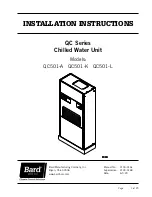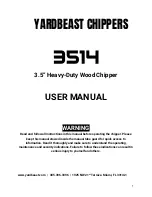
37
14.11 - Variable-speed hot water loop pump
(condenser side)
This pump is factory-installed as standard. It is a variable-
speed pump with available system pressure. See the pump
flow/pressure curve.
The system flow rate is automatically adjusted via the
frequency converter built into the pump, based on the heat
rejection load on the drycooler.
The maximum permitted concentration of the glycol
additives is 35%.
The maximum pump suction pressure is limited to 4 bar due
to the valve installed on the entering water piping.
14.12 - Evaporator and condenser pump suction filter
All evaporator and condenser pumps are protected by a
suction filter. This is easily removable to recover solid
par-ticles, as it is fixed between two Victaulic couplings. It
pro-tects the plate heat exchanger pump against solid
particles with a size exceeding 1,2 mm. Before the unit
start-up it is important to turn the evaporator and
condenser pump to decontaminate the water loops of any
solid pollution.
A specific pump start-up function in the Quick Test menu
is available for this task.
15 - MAINTENANCE
During the unit operating life the service checks and tests
must be carried out in accordance with applicable national
regulations.
If there are no similar criteria in local regulations, the
information on checks during operation in annex C of
standard EN 378-2 can be used.
External visual checks: annex A and B of standard EN378-2.
Corrosion checks: annex D of standard EN 378-2. These
controls must be carried out:
•
After an intervention that is likely to affect the
resis-tance or a change in use or change of high-
pressure refrigerant, or after a shut down of more than
two years. Components that do not comply, must be
changed. Test pressures above the respective
component design pressure must not be applied
(annex B and D).
•
After repair or significant modifications or significant
system or component extension (annex B).
•
After re-installation at another site (annexes A, B and D).
•
After repair following a refrigerant leak (annex D).
The frequency of refrigerant leak detection can vary
from once per year for systems with less than 1% leak
rate per year to once a day for systems with a leak
rate of 35% per year or more. The frequency is in
proportion with the leak rate.
NOTE: high leak rates are not acceptable. The necessary
steps must be taken to eliminate any leak detected.
NOTE 2: Fixed refrigerant detectors are not leak detectors,
as they cannot locate the leak.
15.1 - Soldering and welding
Component, piping and connection soldering and welding
operations must be carried out using the correct procedures
and by qualified operators. Pressurised containers must not
be subjected to shocks, nor to large temperature variations
during maintenance and repair operations.
Any technician attending the machine for any purpose must
be fully qualified to work on refrigerant and electrical
circuits.
WARNINg: Before doing any work on the machine ensure
that the power is switched off. If a refrigerant circuit is
opened, it must be evacuated, recharged and tested for
leaks. Before any operation on a refrigerant circuit, it is
necessary to remove the complete refrigerant charge from
the unit with a refrigerant charge recovery unit.
All removal and refrigerant draining operations must be
carried out by a qualified technician and with the correct
material for the unit. Any inappropriate handling can
lead to uncontrolled fluid or pressure leaks.
If an oil draining or recovery operation becomes necessary,
the fluid transfer must be made using mobile containers.








































